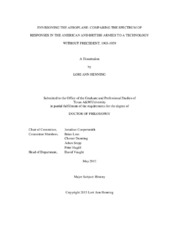| dc.description.abstract | This work examines the unique threat and opportunity posed by aviation to the horse cavalry in the 1900s through the 1930s and how cavalrymen responded. During that period, the American and British cavalries encountered advancing technologies that threatened to change war and directly alter cavalry’s armament, tactics, and overall role.
With airplanes as with bicycles and other new technologies, cavalry officers were cautious. Rather than uncritically embracing or rejecting new technologies completely, cavalrymen tested them before coming to conclusions. Cavalrymen cautiously examined the capabilities of airplanes, developed applications and doctrine for joint operations, and in the United States, even tried to develop their own specially designed aircraft. Airplanes promised to relieve the cavalry of low-priority missions, not threaten its existence.
Instead of replacing the cavalry in the 1910s-1930s, airplanes worked cooperatively with cavalry in reconnaissance, security, communication, protection, and pursuit, a cooperation tested in maneuvers and officially blessed in both British and American doctrine. Just as cavalrymen became dependent on the close working relationship with airplanes in the 1920s-30s, this relationship altered drastically as aviation priorities and doctrine shifted to independent strategic bombardment from tactical support of ground troops. Airplane deployment and development began to overlook the missions of tactical support.
The experiences and responses of American and British cavalrymen to airplanes differed. While the British cavalry was the older organization with a more established institution and traditions, it failed to mount a strong or lasting defense against the encroachments of the nascent aviation service into its reconnaissance and scouting roles. The American cavalry, despite its youth, contested the control of reconnaissance almost immediately in the 1910s and throughout the 1930s, decades after similar arguments ended in Britain.
Grounding this research are a variety of primary and secondary sources including government reports, memoirs, personal journals, books, professional journals, magazines, trade journals, and newspapers. | en |


